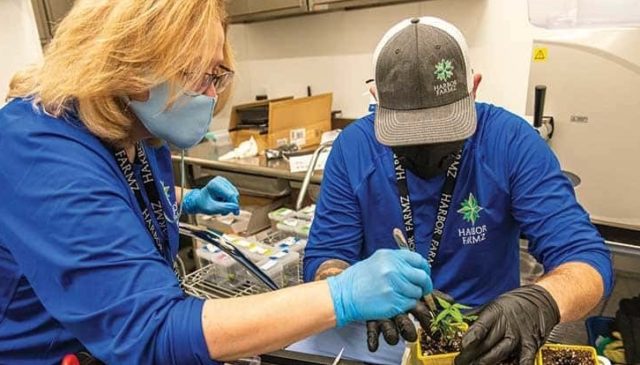
Preventing outbreaks of pests and diseases in growing facilities is a top priority for cannabis cultivators, which is why Harbor Farmz utilizes tissue culture to create the healthiest mother stock plants possible for its nearly 11,000-square-foot canopy.
“The really good thing about having tissue culture in a production facility is that tissue culture is free of any kind of diseases like powdery mildew, botrytis or any kind of viruses, which let’s face it, can make or break a facility,” says Deb Sweeney, tissue culture lab director at Harbor Farmz. “It also reinvigorates the cultivars. When you’ve been cloning plants, you’re cutting them over and over. There’s an open wound there and what’s the plant going to try to do? It’s going to try to heal itself. When there’s an open wound, any kind of systemic disease can go in there.”
Tissue culture plants are incredibly tender and delicate, so Harbor Farmz must provide the best growing environment possible to ensure these plants get a strong start before advancing through its growth stages, Sweeney says. And lighting is one of the most important factors in achieving success throughout the growth cycle.
Here, Sweeney and Allister Malcolm, who also works in the tissue culture lab, share four best practices for lighting in tissue culture.
1. Start Slow and Low
Working in tissue culture is akin to trialing all of the time, as each cultivar has different lighting preferences, Sweeney says.
But no matter the plant, starting at a low lighting intensity is key to prevent the young and fragile plants from burning. Harbor Farmz chose the RAZR LED Series from Fluence by OSRAM, which allows the company to grow tissue culture vertically in a modular system and to keep lights a safe 4 to 8 inches from plants.
“What is great with the RAZR II is its lower intensity lighting, so we’re able to gradually increase it and listen to what the plants want,” Sweeney says. “[LEDs] don’t emit as much heat, and we also save energy.”
2. Consider Space-Saving Tiers
The plant nursery in the tissue culture lab take up less than 20 by 20 feet of space, but thanks to vertical growing, that relatively tiny corner of Harbor Farmz nearly 36,000-square-foot facility holds the beginnings of nearly 1,500 plants at any given time, Malcolm says.
“It’s almost like a bookshelf,” Sweeney says of the shelving units where tissue culture plants grow. “So, it’s literally a shelving unit about 10 feet high, give or take, and we have between 13 and 14 shelves in each shelving unit. We can grow thousands of vessels of tissue culture plants.” The system is possible thanks to the low heat producing LEDs that allow for stacking and close proximity to plants.
3. Gradually Increase Lighting While Watching Plants Closely
Tissue culture plants spend anywhere from four months to a year prepping for the next growth phase in Harbor Farmz’s lab, with the average being six to nine months, Malcolm says.
“When we’re first starting plants out and initiating them, we start them out with a very low level of indirect ambient light,” Malcolm says. “And then after about a month in that very low-level lighting, we’ll bring them into our multiplication stage media, and we’ll increase the light intensity at that point to about 10% of what our lights will let us do. And we use manual controllers on the front of the lighting racks that allow us to adjust that light intensity with just a push of a button.”
The lights allow for small, 1% or 2% adjustments that are ideal for tissue culture plants, he says, so they can slowly dial up the intensity, and they generally do not adjust beyond 5% over the minimum.
“Sometimes that 1% or 2% can make or break you,” Sweeney adds. “I’ve also put the light up too high, and a couple of days later, plants are not happy.”
Sweeney emphasizes that “slow and steady wins the race” when it comes to tissue culture lighting.
“Don’t increase the light too quickly. Listen to what your plants are telling you. If they are not happy, it’s pretty obvious,” Sweeney says, noting that plants will turn yellow or brown.
4. Conduct In-House Research
A light meter is an important tool to measure the exact lighting intensity plants are receiving in order to track that response, Malcolm says.
“We use a light meter to measure light levels to get it dialed in to the point where we want it,” he says.
Sweeney says that the most important key to success in tissue culture is researching as much as possible before starting while continuing to monitor plants’ progress.
“Listen to what other people say but take that with a grain of salt. What works in other people’s facilities may not work in theirs,” she says. “Don’t be afraid to back the intensity down. A lot of what we do is pure research. Each cultivar is different, and we don’t know what they want until they tell us.”
